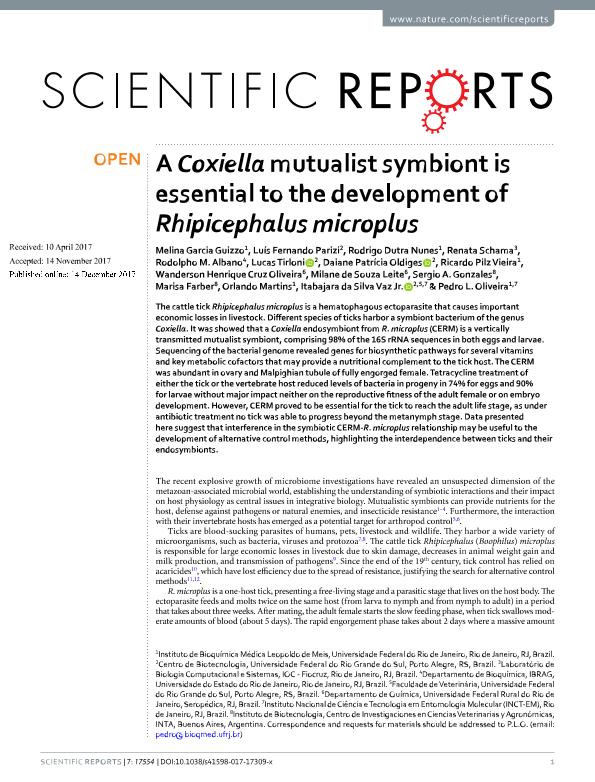Artículo
A Coxiella mutualist symbiont is essential to the development of Rhipicephalus microplus
Garcia Guizzo, Melina; Parizi, Luís Fernando; Nunes, Rodrigo Dutra; Schama, Renata; Albano, Rodolpho M.; Tirloni, Lucas; Oldiges, Daiane Patrícia; Pilz Vieira, Ricardo; Cruz Oliveira, Wanderson Henrique; De Souza Leite, Milane; Gonzales, Sergio A.; Farber, Marisa Diana ; Martins, Orlando; Da Silva Vaz, Itabajara; Oliveira, Pedro L.
; Martins, Orlando; Da Silva Vaz, Itabajara; Oliveira, Pedro L.
 ; Martins, Orlando; Da Silva Vaz, Itabajara; Oliveira, Pedro L.
; Martins, Orlando; Da Silva Vaz, Itabajara; Oliveira, Pedro L.
Fecha de publicación:
12/2017
Editorial:
Nature Publishing Group
Revista:
Scientific Reports
ISSN:
2045-2322
Idioma:
Inglés
Tipo de recurso:
Artículo publicado
Clasificación temática:
Resumen
The cattle tick Rhipicephalus microplus is a hematophagous ectoparasite that causes important economic losses in livestock. Different species of ticks harbor a symbiont bacterium of the genus Coxiella. It was showed that a Coxiella endosymbiont from R. microplus (CERM) is a vertically transmitted mutualist symbiont, comprising 98% of the 16S rRNA sequences in both eggs and larvae. Sequencing of the bacterial genome revealed genes for biosynthetic pathways for several vitamins and key metabolic cofactors that may provide a nutritional complement to the tick host. The CERM was abundant in ovary and Malpighian tubule of fully engorged female. Tetracycline treatment of either the tick or the vertebrate host reduced levels of bacteria in progeny in 74% for eggs and 90% for larvae without major impact neither on the reproductive fitness of the adult female or on embryo development. However, CERM proved to be essential for the tick to reach the adult life stage, as under antibiotic treatment no tick was able to progress beyond the metanymph stage. Data presented here suggest that interference in the symbiotic CERM-R. microplus relationship may be useful to the development of alternative control methods, highlighting the interdependence between ticks and their endosymbionts.
Palabras clave:
Applied Microbiology
,
Symbiosis
,
Metagenomics
,
Ticks
Archivos asociados
Licencia
Identificadores
Colecciones
Articulos(SEDE CENTRAL)
Articulos de SEDE CENTRAL
Articulos de SEDE CENTRAL
Citación
Garcia Guizzo, Melina; Parizi, Luís Fernando; Nunes, Rodrigo Dutra; Schama, Renata; Albano, Rodolpho M.; et al.; A Coxiella mutualist symbiont is essential to the development of Rhipicephalus microplus; Nature Publishing Group; Scientific Reports; 7; 1; 12-2017
Compartir
Altmétricas



